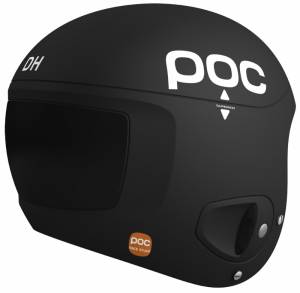Saltsjöbaden, Sweden –Since its founding in 2005, POC’s mission has been to do the best they can to possibly save lives and reduce the consequences of accidents for gravity sports athletes. One topic of discussion throughout that time has been the challenge of vanity versus helmet sizes.
“Once in a while I’m asked the question, ‘How do you make the safest helmet there is?’ The answer’s easy – just make it incredibly big, with decimeters of shock-absorbing material. The downside is that they would be hard to sell and seriously limit movement,” says POC’s founder and CEO, Stefan Ytterborn.
The company’s engineers are constantly trying to come up with new concepts to increase protection and safety, whether it’s a matter of material, construction, design or other practical issues. With a large group of POC users taking big risks, challenging steep and icy slopes to gain perhaps a hundredth of a second, the company has been looking into ways to improve the performance of helmets including a capacity to better absorb energy at far greater speeds than what they are tested and certified for.

Beginning 18 months ago, when developing a new helmet for downhill and super G ski racing, company officials say that they were humbled to realize that there are numerous improvements that can be made to a helmet, and that these improvements need to be made alongside other aspects, such as ensuring the athletes’ physical stamina, the length, steepness and quality of the race line, the netting, equipment improvements and more. The helmet was only one component but by adding around six millimeters (around 30%) to the thickness of the helmet, POC has been able to add the same measure of shock absorbing expanded polypropylene inside. The additional give of this extra thickness provides a more gentle stop and allows the head more travel in high speed impact.
By analyzing serious crashes in downhill racing, POC engineers have found that the speed of impact between the helmet and the ground may be much higher than is stipulated in helmet testing. Their first eye-opener was U.S. Ski Team racer Scott Macartney’s accident in Kitzbühel, where initial analysis showed an impact velocity close to four times the velocity tested for in normal ski standards. When looking at other, similar accidents, speeds anywhere between 20% and 300% higher were observed.
Theoretically, assuming that a helmet is perfectly constructed, a 5-6 mm thick helmet could pass standard ski helmet testing, assuming that the helmet is capable of allowing an ideal constant deceleration of the head, and at the same time only barely passing the standard. No such helmets exist in reality, and most race ski helmets are at least 20 mm thick, four times thicker than in the ideal theory. Applying the same kind of theoretical thinking to the serious downhill accidents analyzed by POC, however, the helmets would need to be between 20-45 mm thick. Continuing this same relation between theory and real life, this equates to a real-life thickness of 80-180 mm. That definitely raises some questions.
Testing of the new POC Skull Comp DH helmets has been performed at speeds higher than those in normal testing, and shows that the extra thickness is well suited to decreasing impact violence at higher speeds. When the helmet was dropped from a height raised by an average 30% compared to normal ski helmet testing, the average decrease of impact violence was between 25-30% in comparison with the company’s normal thickness race ski helmet.
When looking at specific properties in a ski helmet and optimizing it for higher speeds, the problem is the contradiction between high velocity performance and performance at more moderate speeds. This is also a likely accident scenario. If optimizing a helmet at a given thickness for one situation, the risk is that you lose performance at the other end of the scale.
People might feel odd about wearing a bigger helmet. As a first step we’re talking about a 6 mm radius increase. Can someone afford to be vain at 150 kph down an icy slope?

